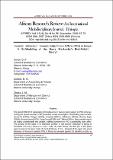| dc.description.abstract | The period 2000-2013 witnessed a tremendous rise in investor participation in IPOs in Kenya. During this period a number of IPOs resulted in over-subscription. Outstanding cases include; Kenya-Re (334%), Kengen (236%), Eveready (800%), Safaricom (363%), Mumias Sugar (200%), Access Kenya (300%), Scan Group (520%) and Telkom (300%). Stock market returns are highly unpredictable and volatile, making investment in IPOs a potentially risky affair. The purpose of this paper is to determine whether or not investor behaviour in Kenya is consistent with Harry Markowitz’s (the H-M) risk-return theory. The first part of this paper seeks to look at the basic tenets of the H-M theory. In the last part of the paper, the actual behaviour of investors towards IPOs in Kenya is surveyed against the standard practice as espoused by the H-M model. This paper concluded that the H-M model does not apply in the Kenyan case. Other factors besides risk and return appear to be influencing investor behaviour towards IPOs in Kenya signalling the need for the remodelling of the H-M model to include these additional factors. Findings by this paper may be valuable to investment policy makers in government and other players in Kenya’s financial markets. Scholars also will also benefit from this paper’s findings by having their knowledge on investment decision-making broadened. | en_US |

